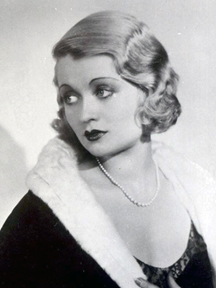Here are 10 things you should know about Jack Mulhall, born 135 years ago today. In his half-century in pictures, he amassed well over 400 film credits.
Tag: Dorothy Mackaill
10 Things You Should Know About Dorothy Mackaill
Here are 10 things you should know about Dorothy Mackaill, born 119 years ago today. She made 65 pictures before the age of 35 and then retired to a life outside the spotlight.
Precode Movies 101: TCM Offers a Primer for Beginners
We’ve acknowledged that the precode era is one of our favorite era in movie history. For those that might not know, precode movies are those made after the ascent of sound but before the Hayes code, which greatly restricted the plot, language, and attitudes that Hollywood pictures were allowed to portray, began to be strictly enforced by the Breen office in 1934.
That quaint, wholesome quality you may associate with old movies? The pictures of the 1930s and ’40s that might convince you, if you don’t already know better, that life was simple, pure and uncomplicated back in the good old days? Those came after the code kicked in. Precode movies are another thing altogether.
Some pictures that typify the precode era are playfully bawdy; others are downright gritty, sometimes even a bit shocking today (though rarely very graphic, by our standards). Tomorrow (Tuesday, July 31st), TCM is giving precode neophytes the chance to do some serious catching up, as they’ll be airing precode favorites all day long, from 6am till 8pm. If you’ve ever wondered what the fuss was all about, here’s your chance to educate yourself.
If it’s gritty you’re looking for, we’d recommend Safe in Hell (1931) and Three on a Match (1932); if you’re just looking for a little salty fun, give Jewel Robbery (1932) and Blonde Crazy (1931) a look. But honestly, we recommend loading up your DVR with every one of these entertaining pictures; they all have something to recommend them.
Here’s the line-up (all times Eastern):
6:00 am — Downstairs (1932)
7:30 am — Loose Ankles (1930)
8:45 am — She Had to Say Yes (1933)
10:00 am — Faithless (1932)
11:30 am — Hell’s Highway (1932)
12:45 pm — Safe in Hell (1931)
2:00 pm — Jewel Robbery (1932)
3:15 pm — Three on a Match (1932)
4:30 pm — Footlight Parade (1933)
6:30 pm — Blonde Crazy (1931)
Happy 114th Birthday, Dorothy Mackaill!
Actress Dorothy Mackaill was born 114 years ago today in Kingston upon Hull, Yorkshire, England. Here are 10 DM Did-You-Knows:
- Mackaill’s parents separated when she was eleven, after which she lived with her father.
- As a teen, she left home for London in pursuit of a career acting on the stage. After a short sting in Paris, she met a Broadway choreographer who convinced her to move to New York City.
- That move paid off, as she was soon made a Follies Girl in the The Ziegfeld Follies and met actresses Marion Davies and Nita Naldi.
- In 1920, Mackaill made her motion picture debut in a movie mystery, The Face at the Window, and also appeared in a number of comedies opposite actor Johnny Hines.
- In 1921, Mackaill’s career received another boost when she was cast in Bits of Life, along with Anna May Wong, Noah Beery and Lon Chaney.
- Mackaill’s star-making role came in 1924, when she appeared in The Man Who Came Back opposite leading man George O’Brien. She was also named, along with Clara Bow and eleven other starlets, a WAMPAS Baby Star.
- The arrival of talking pictures didn’t appear to present a problem for Mackaill—she worked steadily in the early years of the sound era—but she was signed with First National Pictures, which merged with Warner Brothers in 1928, and when her contract ended in 1931, Warners declined to renew it.
- Mackaill continued to work as a free agent, but the roles came less frequently—she made just eight pictures in the next six years before retiring in 1937 to care for her ailing mother.
- In 1955, Mackaill moved to Honolulu, Hawaii, a locale she’d very much enjoyed while filming His Captive Woman there in 1929. She resided at the deluxe Royal Hawaiian Hotel on the beach at Waikiki, swimming in the ocean on a near-daily basis.
- Mackaill acted just three times after 1937, making a single appearance on the anthology television series Studio One in Hollywood in 1953 and two guest spots (in 1976 and 1980) on Hawaii Five-O, which certainly made for an easy commute to work. When she passed away in 1990, her ashes were scattered off her beloved Waikiki beach.
Happy birthday, Dorothy Mackaill, wherever you may be!

Hollywood Undressed, Chapter Twelve
THE TORTURE CHAMBER
 THE boss’s bungalow on the Pathé lot got to be a hangout. Rumors got around about what went on in there. The little stucco shack got christened the Torture Chamber.
THE boss’s bungalow on the Pathé lot got to be a hangout. Rumors got around about what went on in there. The little stucco shack got christened the Torture Chamber.